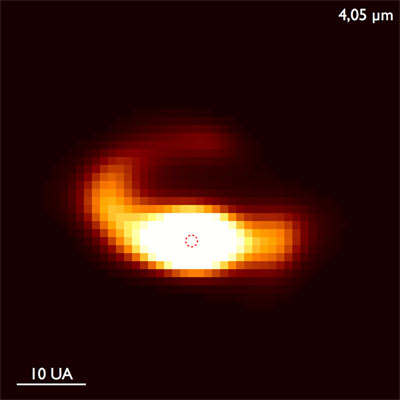
L2 Puppis is a red giant star observable from the southern hemisphere, whose mass is approximately twice that of the Sun. It is estimated that it formed 1.5 Gyr ago, making it a much younger star than the Sun (4.6 Gyr). But due to its higher mass, L2 Pup shined brightly, exhausting its hydrogen supply much faster than our star. L2 Pup has a very large radius, that was measured by the team using the VLT Interferometer at 120 times the Sun, or half of the mean radius of the Earth orbit around the Sun. Its luminosity is also very high, more than 2000 times the Sun. The high radius and luminosity are both typical of the stars that have exhausted their hydrogen supply in their core and are therefore ending their lives.
As a consequence, L2 Pup evolved much faster and is already entering its old age. For comparison, our Sun will go through this phase in approximately 4 Gyrs. At 210 light years, L2 Pup is the nearest evolved star : a critical advantage to resolve fine details in its close environment.
The team used the adaptive optics instrument NACO and serendipitous imaging to correct the distortions introduced on the images by the Earth’s atmosphere. Several thousand very short exposures are recorded on the star. The images that are least affected by the residual atmospheric turbulence are chosen, precisely recentered and combined into a single image, yielding a much higher level of detail than would be possible with a single, longer exposure. The resulting NACO images almost reach the theoretical limit of sharpness attainable for an 8-metre telescope. The angular resolution is as fine as 40 milli-arcseconds, which is roughly the apparent size of a football at a distance of 1000 km.
The exceptional quality of these infrared images (wavelengths between 1 and 4 µm) allowed the team to discover a dusty disk surrounding L2 Pup (color image) seen almost edge-on, as well as a wisp of dust extending up to more than 800 million kilometers from the star.
The discovery of L2 Pup’s dusty disk is an important step toward understanding the fate of low to intermediate mass stars, including our own Sun. There are currently many unknowns on the mechanisms through which these stars end their existence and return their material to the interstellar medium, forming planetary nebulae (expanding gaseous envelopes ejected by the dying star). The presence of this dust disk, very likely formed from material ejected by L2 Pup, indicates that the environment of evolved stars is spatially structured. The formation of bipolar (“hourglass”) planetary nebulae may well be the result of the interaction of the stellar wind with dusty circumstellar disks.

Northeast of L2 Pup, an intriguing loop indicates that gravitational interactions are present in the dusty environment of the star, probably due to a second star orbiting close to L2 Pup, that may also have played a role in the formation of the dust disk. Due to the very high luminosity of the primary star, this companion however remains hidden for the moment. The future second generation, high performance adaptive optics systems such as the SPHERE instrument of the VLT will soon allow to track down this putative companion.

Reference
This research is published in the article “An edge-on translucent dust disk around the nearest AGB star, L2 Puppis” to appear in the European journal Astronomy & Astrophysics on 10 April 2014 : http://dx.doi.org/10.1051/0004-6361/201323273
Collaboration
This research is the result of an international collaboration that includes five French researchers from Observatoire de Paris : Pierre Kervella, Miguel Montargès, Guy Perrin, Sylvestre Lacour et Xavier Haubois.
And also :
Stephen T. Ridgway (National Optical Astronomy Observatories, Tuscon, USA)
Olivier Chesneau (Observatoire de la Côte d’Azur)
Andrea Chiavassa (Observatoire de la Côte d’Azur)
Alexandre Gallenne (Universidad de Concepcion, Chili).
